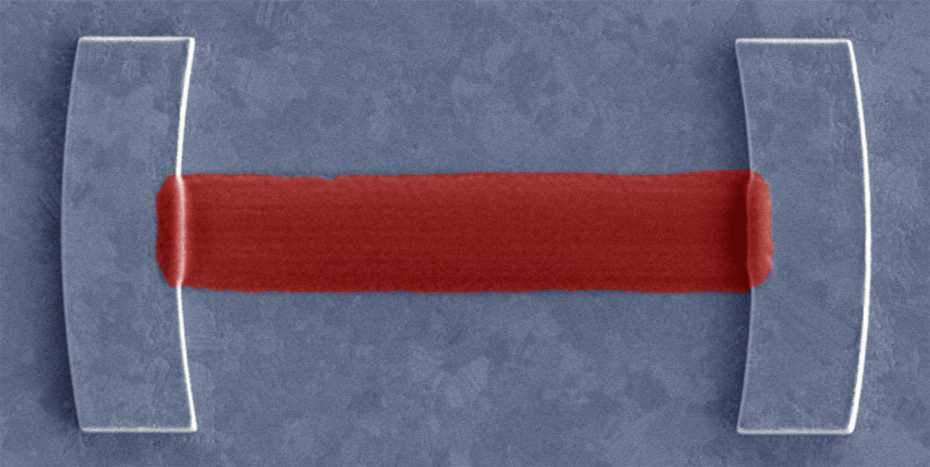16.10.2017
By: Oliver Morsch
Researchers at ETH Zurich have developed a miniature device capable of producing laser-like beams of a particular kind of electromagnetic wave called a surface plasmon. Surface plasmons can be focused much more tightly than light waves, making them useful for applications such as sensing.
When light is confined between two partially reflecting mirrors and amplified by some material in between them, the resulting beam can be extremely bright and of a single colour. This is the working principle of the laser, a tool used in all areas of modern life from the DVD player to the operating theatre.
Researchers at ETH Zurich led by David Norris, professor at the Optical Materials Engineering Laboratory, and Prof. Dimos Poulikakos, professor at the Laboratory of Thermodynamics in Emerging Technologies, have developed a miniature device that applies the same principle to so-called surface plasmons. The electromagnetic waves created by such a surface plasmon laser, or “spaser”, can be focused much more tightly than light, which makes them interesting both for fundamental research and for technical applications such as sensing.
A tiny cavity for surface plasmons
In contrast to ordinary light waves, which propagate freely inside a transparent material, surface plasmons consist of electromagnetic waves that are tightly bound to ripples in the distribution of electrons on the surface of a metal. The optical effects of surface plasmons can be admired, for instance, in the stained glass windows of medieval cathedrals. There, plasmons generated on metallic nanoparticles inside the glass by the incoming light give the windows their peculiar and vibrant colours.
The ETH team has now created the equivalent of a laser cavity for surface plasmons by engineering extremely smooth silver surfaces, on top of which two slightly curved silver blocks, a few micrometres in length and just half a micrometre in height, are placed. These micro-blocks act as the equivalent of the mirrors in a laser. Between the blocks surface plasmons can bounce back and forth many times. Finally, the amplification necessary to obtain a spaser beam is provided by quantum dots that are placed inside the cavity. Quantum dots are tiny semiconductor particles that behave similarly to single atoms (they are sometimes called “artificial atoms”) and can be produced to amplify electromagnetic waves at a desired frequency.
The researchers injected the quantum dots into the spaser cavity by dissolving them in a liquid which was then printed with nanometer precision onto the silver surface through a tiny nozzle, using a technique developed in Poulikakos’s lab. Once the cavity and quantum dots were in place, surface plasmons could be injected into the spaser by shining laser light onto the quantum dots.
Further amplification possible
“In our work we have tried to integrate the basic elements of a spaser in a single small device”, explains Jian Cui, a senior postdoctoral researcher in Norris’s group and author of the study recently published in the scientific journal Science Advances. In addition to the spaser cavity and the gain material, the researchers also included an amplifier that uses quantum dots to further increase the brightness of the surface plasmon beam once it leaves the cavity.
The amplifier has a triangular shape, such that the plasmons are not just amplified, but also focused onto a nanometre-sized tip. There, the electromagnetic waves are concentrated in a volume that is much smaller than the smallest size to which ordinary light could be focused. This feature could be used in the future, for instance, for the highly sensitive detection of biological molecules.
Towards integrated circuits with spasers
Now that they have demonstrated that their miniature spaser works, the ETH researchers are already working on the next logical step. “Our fabrication methods are very reproducible and versatile, so we can now think about creating integrated circuits with multiple elements: spasers, amplifiers, sensing regions, and so forth”, says professor Norris.
The new approach has several advantages compared to previous attempts at realizing spasers. Earlier techniques used a metallic particle as the cavity, which did not allow extraction of the spaser beam. The procedure developed at ETH uses a planar film with integrated mirrors, which gives the researchers more freedom of choice regarding the size and geometry of the cavity, while also allowing them to study the surface plasmons directly.
Reference
Kress S, Cui J, Rohner P, Kim D, Antolinez F, Zaininger K-A, Jayanti S, Richner P, McPeak K, Poulikakos D, Norris D: A customizable class of colloidal-quantum-dot spasers and plasmonic amplifiers. Science Advances, 2017; 9:e1700688, doi: 10.1126/sciadv.1700688














